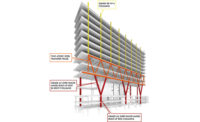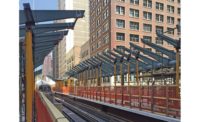Water
Chicago Sees Record Rainfall, Power Outages; No Room in Lake for Runoff
Lower Wacker Drive flooded, river water unable to be drained into Lake Michigan

More than 8 in. of rain fell between May 15 and 17 across the greater Chicago area, flooding Lower Wacker Drive in the city's loop and raising river heights, including the highest level recorded on the Chicago River in more than 60 years.
River gauges on Grand Street showed the Chicago River's height at more than 5 ft Saturday; the last time it was measured that high was in 1956. Water flooded Lower Wacker Drive in the city's two-level downtown. Stranded motorists had to be rescued by the Chicago Fire Dept., which used Zodiac boats to rescue six people from Lower Wacker Drive.
A record 3.53 in. of rain came down May 14, the wettest day on record for May. More rain fell May 15 and 16, and then on May 17, an all-day thunderstorm dropped another 3.11 in., according to the National Weather Service. From May 14 to May 17, the NWS reports that 7.88 in. of rain fell at O’Hare Airport and 6.22 in. of rain fell at Midway, with higher localized totals across the area.
NWS said 8.20 in. has already fallen on the Chicago area over the first 17 days of May. With two weeks to go, only half an inch is needed to set a new May rainfall record. The previous records may be short-lived. with 8.21 in. recorded in 2018 and 8.25 in. in 2019, according to the NWS.
Chicago's Metropolitan Water Reclamation District opened the gates to Lake Michigan and attempted to reverse the flow of the Chicago River to pump the water into the lake, away from residences and businesses, but the water level in the lake was so high on May 17 that the operation didn't immediately work. In order for the MWRD to reverse the flow of the Chicago Area Waterways, the river must be higher than the lake.
"To mitigate the impact of the storm event, we have reversed the flow of the Chicago Area Waterway system to Lake Michigan at the Wilmette Pumping Station and at the Chicago River Controlling Works downtown to minimize over-bank flooding," the MWRD said in a statement.
The Wilmette Pumping Station reversed direction from May 15 at 2:30 a.m. to May 15 at 5:45 a.m. The Wilmette Pumping Station again started to reverse pumping direction May 17 at 3:45 p.m. and that operation is ongoing. The Chicago River Controlling Works in downtown Chicago reversed pumping on May 17 at 7:20 p.m. and is still pumping.
Chicago's Tunnel and Reservoir Plan is comprised of three systems. Combined, they are currently holding more than 8 billion gallons of water. Flood waters are falling as of May 18, but all of the TARP's systems were still near capacity. The McCook Tunnel and Reservoir Plan System was 100% full on May 17 with 4.97 billion gallons of water.
The McCook TARP system is comprised of the city's Mainstream Tunnel, the Des Plaines Tunnel, and the McCook Reservoir. The Calumet TARP System was 36% full, with 3.017 billion gallons stored. That includes the city's Calumet Tunnel and the Thornton Composite Reservoir. The Kirie TARP System Tunnel was 100% full, with 71 million gallons and its Majewski CUP System stored 243 million gallons of water.
As standing water drains from the lakefront and Lower Wacker Drive, the implications for construction projects in the area are not clear. A ComEd power substation on Lower Wacker Drive was damaged by the flood waters and power was still out to the Willis Tower on the morning of May 18.




